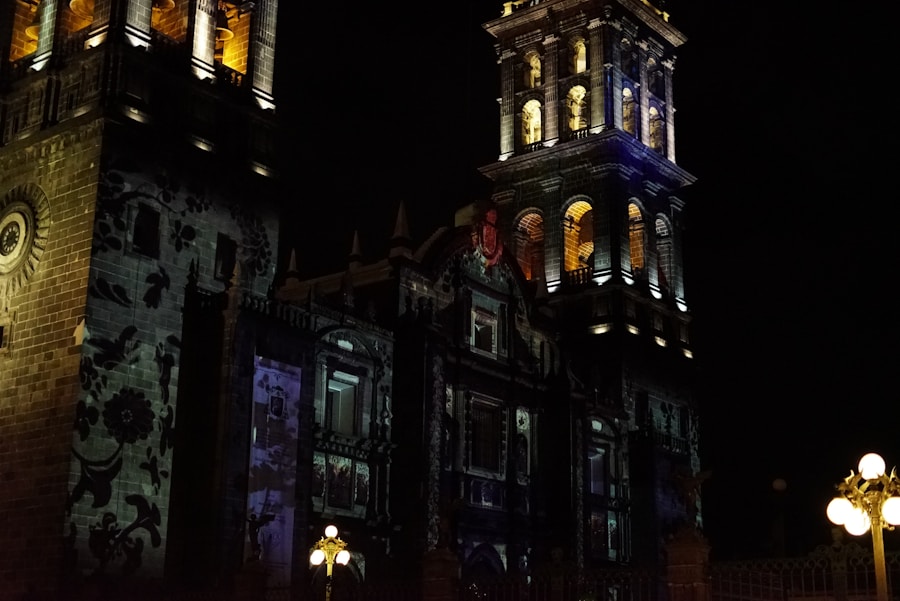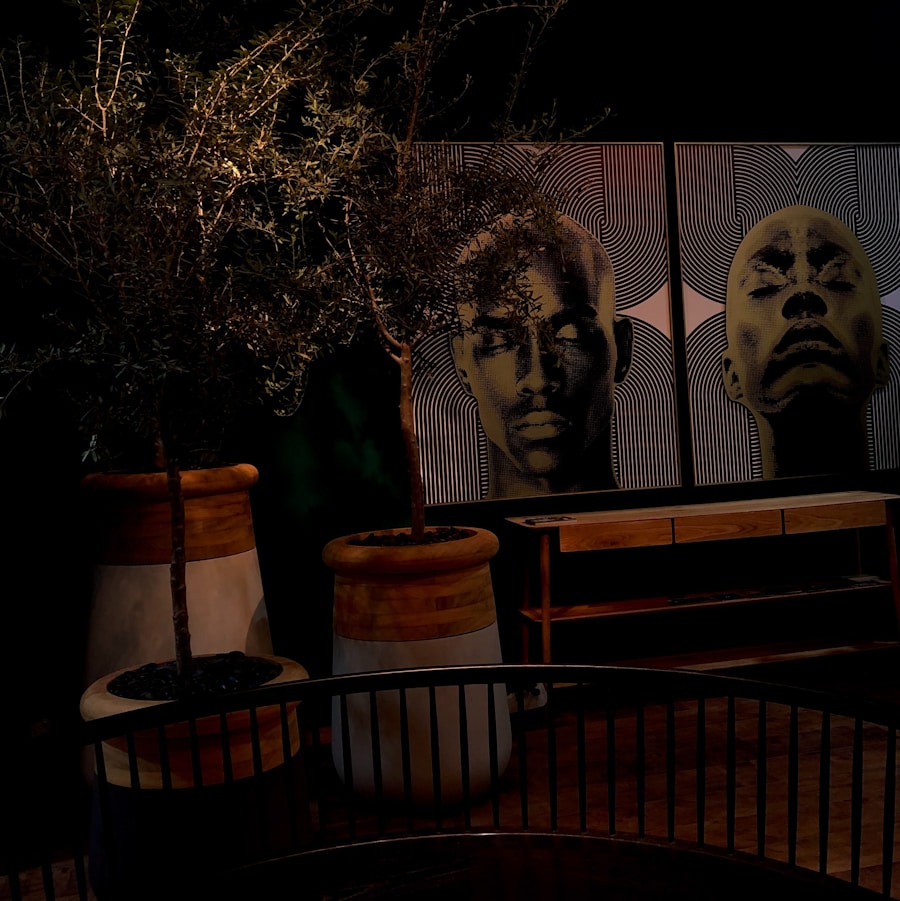Projection mapping is a cutting-edge technology that transforms ordinary surfaces into dynamic visual displays. By utilizing specialized software and projectors, we can project images, videos, and animations onto three-dimensional objects, creating an illusion of movement and depth. This technique allows us to manipulate the perception of space, making it possible to turn buildings, stages, and even small props into captivating visual experiences.
The beauty of projection mapping lies in its versatility; it can be used for various applications, from art installations to advertising campaigns, and, notably, in the realm of entertainment. In the context of haunted houses, projection mapping serves as a powerful tool to enhance storytelling and create an immersive environment. By projecting eerie visuals onto walls, floors, and props, we can evoke emotions and reactions that traditional decorations might not achieve.
The ability to synchronize these projections with sound effects and lighting further amplifies the overall experience, drawing visitors deeper into the narrative we aim to convey. As we explore the evolution of haunted house experiences, it becomes clear that projection mapping is not just a trend but a transformative element that redefines how we engage with fear and excitement.
Key Takeaways
- Projection mapping is a technique that uses specialized software to project images onto 3D surfaces, creating the illusion of movement and depth.
- Haunted house experiences have evolved from simple jump scares to immersive, interactive environments that use technology like projection mapping to enhance the experience.
- Projection mapping enhances haunted house experiences by creating dynamic and interactive visuals that can transform the environment and surprise and scare visitors.
- Projection mapping helps create an immersive atmosphere in haunted houses by allowing for the manipulation of space, light, and sound to create a truly immersive and terrifying experience.
- The technology behind projection mapping in haunted houses involves specialized software, projectors, and 3D mapping techniques to create realistic and dynamic visuals that can bring the environment to life.
The Evolution of Haunted House Experiences
The Early Days of Haunted Houses
Initially, these experiences were often rooted in folklore and local legends, relying on the power of storytelling to evoke fear. As time progressed, we saw the introduction of physical props and actors dressed as ghouls and monsters, which added a tangible element to the frightful experience.
Advancements in Technology and Audience Engagement
However, these early haunted houses were limited by their reliance on static displays and basic theatrical techniques.
The introduction of animatronics brought a new level of realism to the scares, allowing for lifelike movements and interactions.
The Digital Age of Haunted Houses
As we moved into the digital age, the integration of sound design and lighting effects further enhanced the atmosphere. Today, we find ourselves at a crossroads where traditional methods meet innovative technologies like projection mapping, allowing us to create experiences that are not only visually stunning but also deeply immersive.
How Projection Mapping Enhances the Haunted House Experience

Projection mapping elevates the haunted house experience by adding layers of visual storytelling that captivate our senses. Instead of relying solely on physical props or actors to convey fear, we can use projections to create dynamic scenes that change in real-time. For instance, a wall that appears to be crumbling can suddenly reveal ghostly apparitions or flickering shadows that dance across the surface.
This fluidity keeps visitors on edge, as they never know what might happen next. The unpredictability of projection mapping adds an element of surprise that traditional haunted house elements often lack. Moreover, projection mapping allows us to create environments that would be impossible or impractical to construct physically.
We can transport visitors to haunted forests, abandoned asylums, or eerie graveyards without needing extensive sets or props. This flexibility not only saves on production costs but also enables us to craft intricate narratives that unfold as guests move through different areas of the attraction. By seamlessly integrating projections with soundscapes and lighting effects, we can create a cohesive experience that immerses visitors in a world where fear feels palpable and real.
Creating an Immersive Atmosphere with Projection Mapping
| Metrics | Value |
|---|---|
| Number of Projection Mapping Installations | 200 |
| Percentage Increase in Event Attendance | 30% |
| Customer Satisfaction Rating | 4.8 out of 5 |
| Media Impressions Generated | 500,000 |
To create an immersive atmosphere using projection mapping, we must consider every aspect of the visitor’s experience. The key lies in designing projections that complement the physical environment while enhancing the overall narrative. For example, if we are creating a haunted forest scene, we can project images of swaying trees and flickering lights that mimic fireflies.
This not only adds depth to the setting but also engages our audience’s imagination, allowing them to feel as though they are truly walking through a haunted woodland. Additionally, synchronization is crucial in crafting an immersive atmosphere. By aligning projections with sound effects and lighting changes, we can create moments of tension and release that heighten emotional responses.
Imagine walking through a dimly lit corridor when suddenly, a chilling scream echoes through the air as ghostly figures emerge from the walls. This combination of audio-visual elements creates a multi-sensory experience that lingers in our minds long after we’ve left the haunted house. By thoughtfully designing each element of the experience, we can ensure that projection mapping serves as a powerful tool for immersion rather than just a flashy gimmick.
The Technology Behind Projection Mapping in Haunted Houses
The technology behind projection mapping involves a combination of hardware and software that work together to create stunning visual displays. At its core, we rely on high-quality projectors capable of producing bright and vibrant images even in low-light environments. These projectors are often paired with specialized software that allows us to map visuals onto irregular surfaces accurately.
This software enables us to adjust the size, shape, and orientation of our projections to fit seamlessly within the physical space. In addition to projectors and software, we also utilize sensors and motion tracking technology to enhance interactivity within our haunted houses. By incorporating these elements, we can create responsive environments where projections react to visitors’ movements or actions.
For instance, as guests walk through a room, they might trigger ghostly apparitions that appear only when they approach certain areas. This level of interactivity not only adds excitement but also encourages exploration, making each visit unique as no two experiences are ever quite the same.
Projection Mapping in Different Areas of the Haunted House

Setting the Mood
In entryways or waiting areas, projection mapping can be used to set the tone before guests even step inside. By combining eerie visuals with unsettling sounds, we can build anticipation and prepare visitors for what lies ahead.
This helps to create a cohesive and immersive experience that keeps visitors engaged and frightened.
Creating Focal Points
In specific rooms or zones within the haunted house, projection mapping can be used to create focal points that draw attention and elicit fear. For example, in a creepy laboratory setting, we might project bubbling potions or flickering lights to suggest something sinister is at work. In a haunted graveyard area, projections of swirling fog or ghostly figures can enhance the atmosphere while keeping guests on edge. By strategically placing projections throughout the attraction, we can guide visitors through a carefully curated journey filled with surprises at every turn.
The Impact of Projection Mapping on the Haunted House Industry
The introduction of projection mapping has had a profound impact on the haunted house industry as a whole. As audiences become increasingly sophisticated in their entertainment preferences, attractions must adapt to meet these expectations. Projection mapping allows us to push creative boundaries and offer experiences that are visually stunning and emotionally engaging.
This innovation has led to an increase in attendance at haunted houses that embrace this technology, as word-of-mouth spreads about their unique offerings. Moreover, projection mapping has opened up new avenues for storytelling within haunted houses. We can now craft intricate narratives that unfold through visual cues rather than relying solely on static displays or scripted dialogue from actors.
This shift has encouraged more creative collaboration among designers, artists, and technologists who work together to bring these immersive experiences to life. As we continue to explore the possibilities of projection mapping in haunted houses, it is clear that this technology will play a pivotal role in shaping the future of fear-based entertainment.
Tips for Creating a Successful Immersive Haunted House Experience with Projection Mapping
To create a successful immersive haunted house experience using projection mapping, we must prioritize careful planning and execution at every stage of development. First and foremost, it is essential to have a clear narrative in mind before diving into design elements. A well-defined story will guide our decisions regarding visuals, soundscapes, and overall atmosphere while ensuring that every aspect contributes meaningfully to the experience.
Next, we should invest time in testing our projections within the physical space before opening to the public. This allows us to identify any potential issues with alignment or visibility while ensuring that all elements work harmoniously together. Additionally, gathering feedback from test audiences can provide valuable insights into what resonates with visitors and what may need adjustment.
Finally, embracing creativity is key when utilizing projection mapping in haunted houses. We should not shy away from experimenting with unconventional ideas or techniques; after all, pushing boundaries is what keeps audiences engaged and excited about returning year after year. By combining innovative technology with compelling storytelling and immersive design elements, we can craft unforgettable experiences that leave lasting impressions on all who dare to enter our haunted realms.
If you’re interested in learning more about haunted houses and the technology used to create immersive experiences, check out this article on the best haunted attractions in the Midwest. This article explores some of the top haunted houses in the region and how they use cutting-edge technology like projection mapping to scare and entertain visitors. It’s a fascinating look at how technology is changing the haunted house industry and creating new and exciting experiences for thrill-seekers.
FAQs
What is projection mapping?
Projection mapping, also known as video mapping or spatial augmented reality, is a technology used to project images or videos onto irregularly shaped surfaces, such as buildings, to create the illusion of movement and depth.
How is projection mapping used in haunted houses?
Projection mapping is used in haunted houses to create immersive and interactive experiences for visitors. It can be used to project spooky images, animations, and special effects onto walls, floors, and props to enhance the overall atmosphere and scare factor.
What are the benefits of using projection mapping in haunted houses?
Projection mapping allows haunted house designers to create dynamic and customizable experiences that can be easily changed or updated. It also provides a more immersive and realistic environment for visitors, making the scares more impactful.
What are some popular examples of projection mapping in haunted houses?
Some popular examples of projection mapping in haunted houses include using it to create ghostly apparitions, eerie landscapes, and interactive elements that respond to visitors’ movements.
What are the challenges of using projection mapping in haunted houses?
Some challenges of using projection mapping in haunted houses include the need for precise calibration and alignment of projectors, as well as the potential for technical issues such as image distortion or color inconsistencies. Additionally, the cost of equipment and expertise required for projection mapping can be a barrier for some haunted house operators.

Comments are closed